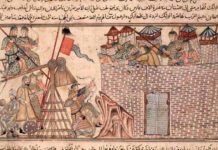The area known later as Vietnam was called Indochina before the formation of Vietnam in 1954. It was a French colony before and after World War II. The Japanese seized it during the war, and it was during this period that a nationalist named Ho Chi Minh, formed a band of soldiers called the Vietminh. They tried to defeat the Japanese and form an independent country but was unsuccessful. But once World War II ended, the French quickly regained Indochina as a result of Japan’s surrender.
The Indochina War
The nationalist forces under Ho Chi Minh then tried to overthrow the French colonial government there one year after the war. Ho asked the United States for military and economic aid but it didn’t answer them. It was known by the Truman Administration that Ho was a communist trained in Marxist ideology in Moscow, but he was first and foremost a nationalist believing his land should be an independent country. The U.S. by this point was fearful of Ho’s marxism and provided financial aid to the French forces in Indochina. By 1950, the U.S was providing 70 percent of French war costs. In 1954, French forces were overwhelmed by Ho’s guerrilla tactics and were surrounded in the city of Dienbienphu. Although U.S. President Dwight D. Eisenhower was committed to defeating communism from taking over countries and territories, he refused to involving U.S. forces directly in the conflict. As a result, the French were defeated at Dienbienphu on May 7, 1954, ending the war.
The Formation of Vietnam
A conference of Ho Chi Minh and his aides, and France in Geneva, without the U.S., formed an agreement that France give up Indochina and that a new nation be formed, named by Ho as Vietnam. It was not a complete agreement, resulting in a temporary division of Vietnam, divided by a line that ran across the 17th parellel. The communists would control the northern part and a pro-democratic regime would control the southern part. Democratic elections were planned for 1956. The agreement ended French rule and commitment in Indochina and slowly started American involvement.
President Eisenhower said that if Indochina fell to communism, the rest of Southeast Asia would topple like dominoes (and it wouldn’t be long until they would begin toppling in the Western Hemisphere). Eisenhower was committed to free elections in Vietnam, but he realized that Ho was so popular in Indochina that he would win any election there. So, he helped establish a pro-American government in the south. He endorsed a wealthy, Catholic, but corrupt man named Ngo Dinh Diem. He assured Eisenhower that he would not permit free elections, but was relying on the U.S. to protect them from communist forces in the north in attacking the south. The U.S. also supplied aid to South Vietnam.
The Vietnam War
In early 1957, guerrillas called the Viet Cong (South Vietnamese communists, supporting North Vietnam), began raiding farm villages in South Vietnam. Many were communists but not all of them were. Some were just people who resented the corrupt South Vietnamese government for not permitting enough freedom and basic necessities of life. Some of the toughest Viet Cong had been fighting for about 20 years, first (as the Viet Minh) against Japanese military occupiers, then French colonial forces, and now (as the Viet Cong) against the South Vietnamese forces and U.S. forces in South Vietnam. The U.S. was now involved in another war in what used to be called Indochina. It sent economic and military supplies to Vietnam. This started American involvement in the Vietnam War.
References:
- Brinkley, Alan. Current, Richard N. Freidel, Frank. Williams, T. Harry. American History, A Survey, Seventh Edition, Volume II: Since 1865. 1985. Pages 847-848.
- Field Enterprises. World Book Encyclopedia (Vietnam War). 1972. Page 292
- Harper, Andrew. Class notes from Interpretations of American History II. 2005.








